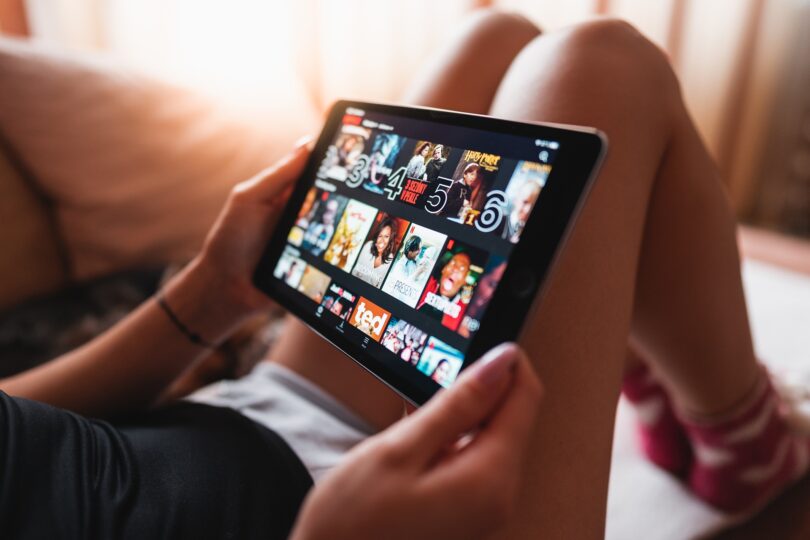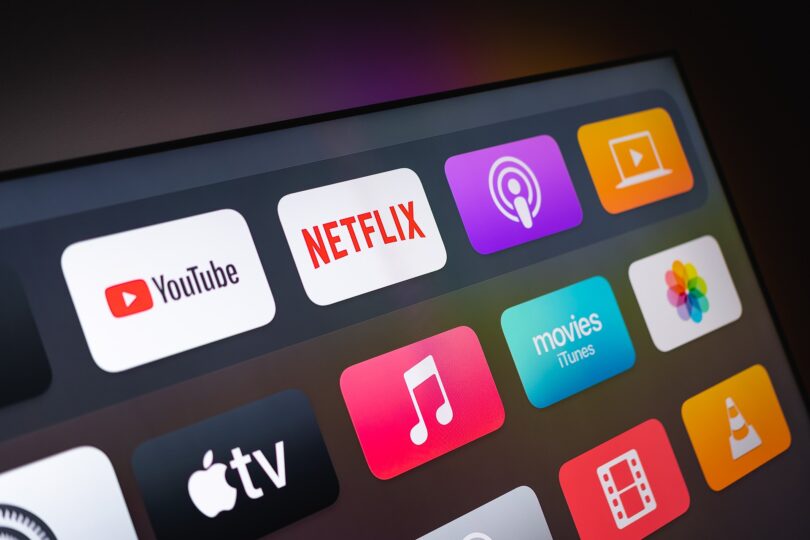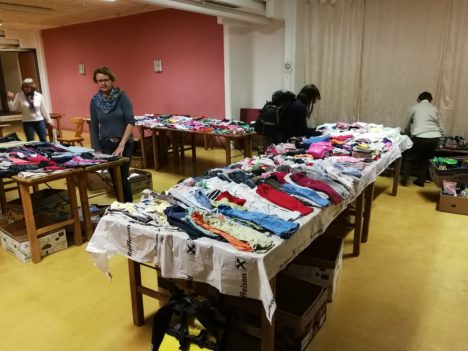Original post by kathi in German on January 19, 2023 (Netflix & Co – Emissionsarmes Video-Streaming). Translated by Lisa Scheer in 2023/24.
Disclaimer: Some of the links in this post might redirect you to a site in German. Feel free to use Machine Translation (such as DeepL or Google Translate) to get the information provided on these sites.
„Streaming videos is the new flying“…

In 2019, different media, among them „Neue Zürcher Zeitung“ used this title. The reason for this was a study by the French thinktank „The Shift Project“ that tackled the issue of rising emissions due to online videos. While many people already do know about the ecological cost of material goods and everyday behaviour such as driving cars, our digital life often remains a blind spot. Unfortunately, digital does not automatically mean environmentally friendly. There are some tips for low-emission video streaming though.
Who is streaming what?
Video streaming has become a part of our daily lives for many. Service providers such as Amazon Prime, Netflix, Disney or Sky offer a wide array of series and movies 24/7. TikTok and YouTube allow us to become content creators ourselves. Everyday countless videos are shared on social media platforms such as Instagram and Facebook. There are also ads on apps and websites. User frequency and the duration of video streaming is continuously rising, particularly among teenagers and young adults. According to a survey conducted in 2022, Austrians stream 54 minutes of content per day. Young people even do so for about 2 hours a day. A study by DAK, a German health insurance provider, in 2021 indicated that teenagers spend more time on streaming services such as YouTube and Netflix than with video games and social media.
The consumption of different kinds of online videos consists of:
- 34% video on demand streaming (Netflix, Amazon Prime, etc.)
- 27% pornography
- 21% YouTube and smaller platforms
- 18% other (e.g. on social media platforms such as Instagram, TikTok, and more…)
How much energy does video streaming need?
According to Boston Consulting Group in 2020, the information and communication industry created „more than 3%“ of CO2-emissions worldwide. A study conducted in 2021 estimates the emissions of the whole industry to 2.1%-3.9% high. In comparison, the flight industry creates around 3%-3.5%. The lion’s share of emissions is due to the Internet – according to estimations that is 1.9%-3.2% of CO2-emissions worldwide. Around 80% thereof are created by video streaming.
The French thinktank „The Shift Project“ in 2019 stated that half an hour of streaming amounts to 1.6 kilogrammes of CO2, which is a drive of more than 6 kilometres. According to Carbon Trust, the European mean of one hour of streaming is about 55 grammes of CO2, which is a distance of 300 metres in a car. While the first study cited is based on estimates, the second study is based on observed average values. This discrepancy is due to the fact that the actual consumption of one hour of video streams varies greatly based on the data centre of the service provider, transmission route and the terminal used.

Where does the energy use in streaming come from?
Each streaming platform has huge data centres. With their help, content is provided. The consumption of the data centre depends on how efficient their devices are and if they are optimally adapted to utilisation. But the needed cooling of the servers also impacts these numbers. The next essential energy driver is the transmission path of the video data from the provider’s data centre to the consumer via Internet cable or mobile communications. Last but not least, we need to add the consumption of end devices such as TVs, tablets or cell phones.
The providers‘ responsibility
The consumption within the data centre is specified by the service provider and can only be influenced indirectly by the consumer, such as by choosing a different provider. Providers can also put importance on bettering their technology, such as more efficient cooling systems, the use of waste heat and the reduction of data volume (such as through the improvement of data formats). They can also use more renewable energies when it comes to their electricity. According to the German Federal Environment Agency, data processing in the data centre produces around 1.5g of CO2 per hour.
In 2017, Greenpeace („Click Green Study“) compared different streaming platforms based on their information on where their electricity comes from. YouTube received the best grade „A“, Amazon Prime received a „C“ and Netflix a „D“.
Ever since then streaming platforms have more or less presented ambitious strategies for sustainability. Netflix, for example, has named a CO2-footprint of 1 million tons in 2020 and wanted to achieve „net zero emissions“ through cutbacks and compensation projects. It is important to note that Netflix only considers the first step in the streaming process here. The transmission paths and terminals required for streaming are not included.
Stricter ambitions when it comes to sustainability could pay off economically for the providers. About half of the users indicate in survey that they would prefer streaming platforms that focus on using solely renewable energies.

The role of transmission paths
Video data reaches the consumer’s screen from the provider’s data centre via Internet cable or mobile communications. It matters how this is done. A study of the German Federal Environmental Agency shows the following overview on consumption from the data centre including transmission:
- Fiber optic cable and Wi-Fi: 2 grammes of CO2 / hour
- Copper cable: 4 grammes of CO2 / hour
- 5G: 5 grammes of CO2 / hour
- UMTS (3G): 90 grammes of CO2 / hour
We can gain two insights from this: for one, internet cables are superior to mobile telephony and secondly, modern mobile communications such as 5G are more efficiently than older systems. Consumers can influence their CO2-emissions by showing greater sensibility when it comes to streaming videos via mobile telephony. Politics can also step in here. Providing more public Wi-Fi hotspots, for example, could positively impact CO2-Emissions. Subventions for more modern transmission routes such as glass fibre cables can also help.
Last but not least – the terminal and its settings
The device from which streams are viewed (Smart-TV, Tablet or mobile…) makes a big difference. As a rule of thumb, the smaller the screen, the fewer emissions and the smaller the resolution, the fewer emissions.
For example: A movie in ultra-HD resolution needs 7 GB per hour, HD-Quality needs 700 MB. The latter therefore needs a tenth (!) of the data.
The good news is that the consumer can reduce emissions by choosing terminal and by optimising the settings. Here we have some inspirations for you:
What can I do to lower my ecologic footprint when streaming?
- Register renewable energies at home:
- The energy we use should preferably come from renewable sources. It’s best to check your electricity contract and change to a provider of ecological electricity.
- Use devices you already have for as long as possible and look at energy consumption when buying a new device
- The emissions created during production of technical devices are often underestimated. It is recommended to buy quality products and to use them for as long as possible. When buying a new device, such as a Smart TV, look at the energy class. Ever since March 2021, there has been a new EU Energy Labels with a efficiency scale ranging from A to G. Pay attention: Efficiency class only indicates, how efficient a device is. The actual energy consumption depends on screen size. The bigger the screen, the bigger the consumption. LED- or OLED-screens are generally more energy efficient than LCD-screens.
- Repair broken devices if possible and at the end of their lifetime get rid of them accordingly.
- Prefer smaller screens:
- If you are watching series alone in the evenings, a tablet might suffice instead of using a large TV.
- When buying a new TV be moderate: technological advances that save energy might unfortunately be eradicated by a larger screen size and bigger resolutions ( à Rebound-Effekt)
- Reduce the resolution:
- A high resolution is often suggested which does not make any sense on a smaller screen, such as on your smartphone. Look at the settings of frequently used providers.
- How does it work on YouTube? Click on settings (in the lower bar) – select Quality – use 360p or less.
- Deactivate autoplay:
- Some social media apps and browsers – unfortunately not all – can stop videos from playing automatically. This function often is hidden fairly well in the settings.
- Install ad-blockers and close unused tabs:
- You have a couple of tabs open and suddenly an ad starts playing in one of them? Not only is this annoying but it also uses up data. Use an ad-blocker and close tabs that are no longer needed.
- Reduce streaming in mobile telephony while out and about:
- Even if your very own mobile phone contract doesn’t allow it, it is advisable to sign into available Wi-Fi (for example at your friend’s place or at university). For data that you use more frequently when out (such as your favourite music or videos), check if you can download them.
- Observe when you take out your phone out of boredom (such as on public transport) and think about alternatives – bring a book or plan your weekly shopping.
- When only audio is needed, avoid videos:
- If the audio is more important (such as when playing music) use iTunes or Spotify instead of YouTube.
- Apart from music, some content creators are available on many platforms and sometimes will provide audio-only versions of their content.
- If certain music or talks are only available on YouTube, you can try out an „audio-only“ plug-in.
- Think about your media consumption in earnest.
- Look at your own streaming behaviours:
- Look at your daily screentime when it comes to streaming for a week. On a smartphone you can have a look at your battery settings to get an idea of which apps need the most energy. If you want to find out more in detail, install a surveillance app (such as Digitox).
- Define a weekly maximum:
- How about setting up a daily limit or planning streaming free days? For more discipline, you can install apps on your smartphone that block certain applications and websites (for certain periods of time).
- Quality instead of quantity:
- Think about which content, topics and titles are truly interesting for you and make a list. Pay attention to the movie: If you are playing on your mobile, because a movie is boring, emits doubly.
- Have alternatives ready:
- The habit of streaming videos in the evening can be replaced with other activities during some evenings of a week, such as borrowing a book or a board game or going on a walk.
- Together is less lonely:
- If you want to watch new, visually stunning series on a big TV, do so with one or many of your friends. Just as in the car: The more the merrier!
- Look at your own streaming behaviours:
Sources:
- Video-Streaming: Art der Datenübertragung entscheidend für Klimabilanz, Gemeinsame Pressemitteilung von Bundesumweltministerium und Umweltbundesamt Deutschland, 10.09.2020
https://www.umweltbundesamt.de/presse/pressemitteilungen/video-streaming-art-der-datenuebertragung - Die CO2-Bilanz von Streaming: So streamst Du nachhaltiger, Contentflow.de
https://contentflow.de/streaming-co2-bilanz-so-streamst-du-nachhaltiger/ - Das neue Fliegen: Streaming verursacht immer mehr CO2, Der Standard, 06.01.2020
https://www.derstandard.at/story/2000112891248/das-neue-fliegen-streaming-verursacht-immer-mehr-co2 - Netflix gibt sich grünes Image – und weist Veranwortung für CO2-Ausstoß beim Streaming von sich, Handelsblatt, 30.03.2021
https://www.handelsblatt.com/technik/digitale-revolution/streamingdienst-netflix-gibt-sich-gruenes-image-und-weist-veranwortung-fuer-co2-ausstoss-beim-streaming-von-sich/27048790.html - Streaming und Whatsapp – wie sehr unsere Internet-Nutzung dem Klima schadet, Stern, 14.10.2022
https://www.stern.de/panorama/wissen/streaming-und-whatsapp–wie-internet-nutzung-dem-klima-schadet–video–9539166.html - Das nächste Video besser über Glasfaser streamen, Süddeutsche Zeitung, 10.09.2020
https://www.sueddeutsche.de/digital/streaming-klima-studie-1.5027701 - Carbon Impact of Video Streaming, Carbon Trust, 06.2021
https://www.carbontrust.com/resources/carbon-impact-of-video-streaming - Nachhaltigkeit von Streaming und Co, Bitkom, 2020
https://www.bitkom.org/Bitkom/Publikationen/Nachhaltigkeit-von-Streaming-Co - Videostreaming bei Jugendlichen enorm gestiegen, Der Spiegel, 09.03.2022
https://www.spiegel.de/kultur/dak-studie-jugendliche-verbringen-immer-mehr-zeit-mit-video-streaming-a-1404f39d-33e7-4980-86d8-836a23d03fdb - Statistiken zum Thema Video-Streaming in Österreich, Statista.com, 21.12.2022
https://de.statista.com/themen/4822/onlinevideo-nutzung-in-der-oesterreich/#topicHeader__wrapper - Streaming – Nutzer achten auch auf Nachhaltigkeit, Stern, 28.04.2021
https://www.stern.de/kultur/streaming–nutzer-achten-auch-auf-nachhaltigkeit-30503172.html - Telekommunikationsbranche befähigt andere Industrien ihren CO2-Ausstoß bis zu 30 Prozent zu senken, The Boston Consulting Group, 04.2020
https://www.bcg.com/press/04maerz2020_telco_sustainability - The real climate and transformative impact of ICT: A critique of estimates, trends, and regulations, Freitag et al., 10.2021
https://www.cell.com/patterns/fulltext/S2666-3899(21)00188-4?_returnURL=https%3A%2F%2Flinkinghub.elsevier.com%2Fretrieve%2Fpii%2FS2666389921001884%3Fshowall%3Dtrue%23secsectitle0190 - Streaming ist das neue Fliegen – wie der digitale Konsum das Klima belastet, Neue Zürcher Zeitung, 16.04.2019
https://www.nzz.ch/wirtschaft/streaming-ist-das-neue-fliegen-wie-der-digitale-konsum-das-klima-schaedigt-ld.1474563?reduced=true - Clicking Clean – Who is winning the race to build a green internet? Greenpeace, 2017
http://www.clickclean.org/austria/de/
Anmerkung der NiG-Redaktion:
Falls du keine wichtigen Beiträge oder Termine von uns verpassen willst, abonnier doch bitte gerne unseren Newsletter! Er kommt unregelmäßig und nicht zu häufig – versprochen. Oder schau regelmäßig in unseren Veranstaltungskalender.
Wenn dir gefällt, was wir auf dieser Plattform tun, nämlich bereits seit 2017 über Nachhaltigkeit, Umwelt- und Klimaschutz zu informieren, dann unterstütz uns doch bitte auch finanziell, um unsere Website in dieser Qualität und Fülle weiterführen zu können – uns hilft jeder Beitrag!
Verein „Nachhaltig in Graz“
BIC: STSPAT2GXXX
IBAN: AT20 2081 5000 4200 1552
Verwendungszweck: Spende/Sponsoring (Mehr zum Sponsoring hier)
Du kannst dir auch gerne unsere kostenlose App aufs Handy laden, damit kannst du Informationen, Veranstaltungen und vieles mehr entdecken: App Nachhaltig in Graz














